Without much fanfare, Apple quietly released its ‘Mac for the Rest of Us’ today, January 11, 2005, via the new Mac mini. January had been a favorite month of Apple’s co-founder, Steve Jobs, to launch new products. Very memorable was the Jan. 24, 1984 unveiling of the very first Macintosh which was made even more astounding by the famous “1984-Big Brother” ad, which aired two days earlier -Jan. 22, 1984 -, during the halftime of Super Bowl XVIII between the L.A. Raiders and the Washington Redskins.
And so, off I went to the nearest Apple Store in our area (the Palo Alto Apple mini store inside the Stanford Shopping Center, was one of the very first Apple Stores to have the Mac mini on display) to check out this yet new release by Steve and his bright band of engineers.
The Mac mini is Apple’s latest -and, bold -attempt to lure Windows/PC users to the glamorous world of Mac OS X. Bold, in a sense that, this is the first time they released a “bare-bones” Mac. Normally, Apple bundles a keyboard and mouse for any system they sell without a monitor. Now, with the Mac mini, all one gets is the basic system or “CPU unit.” Users, will have to make do with his/her own monitor, keyboard and mouse to come up with a fully-functioning Mac. It’s “BYODKM” -Bring-Your-Own-Display-Keyboard & Mouse-, as Jobs aptly coined it at the recent 2005 MacWorld Expo held at the Moscone Center in downtown San Francisco.
The squat, 6.5″ x 6.5″ x 2″ aluminum-clad unit with a white-colored top comes with two (2) USB ports -obviously for keyboard and another USB-enabled device that is oh, so, very common in the world of Windows/PC-, one (1) FireWire port -for that much faster iPod/iTunes music and DV transfers -, a 10/100 Ethernet -for that essential, fast Internet-sharing/networking connection -, and the eternally-present, 56K modem port.
   
 
One drag, unlike in the iMac G5, is that the power supply was not built-in on the unit. Hence, another power brick is included in the package. The white-colored power cube (the size of which was similar to the one that came with the PowerBook 2400 series) provides a continuous 85W of power that the unit requires. The reason for not including the PS inside the tightly-packed unit must be due to the bitter lessons learnt by the company, in much of the power supply failures in their also miniscule, G4 Cube. Apple, in describing the Mac mini in their website, had tried their very best to hide this fact from web visitors, to deter at any ‘hint of clutter’ to the unquestionably elegant unit.
   
 
Windows ‘switchers’ won’t have to purchase any other adapters (most PS/2 keyboards or mice come with USB adapters anyway) to use the Mac mini right off the box. An analog (15-pin) VGA adapter is included so that you can hook it up to your VGA monitor. You may have to buy the Apple DVI to Video Adapter if you want to hook up your TV instead.
The built-in speakers may remind you of the sounds coming from your iBook but a headphone/audio-out connector seems to quell any mutterings of the audiophile…that is almost inherent in even the most casual of Mac user.
Aside from its size, it is the almost total quietness of the unit that seem to marvel the true Mac enthusiast. Normally, compact units,- even in the PC realm – generate a slight whine that emanates from either the power supply’s or CPU’s fan. Since Apple had almost perfected the art of convection-cooling,- and that the power supply is separate – when they released the G4 Cube, the unit merely sits in its utter stillness alongside any other widgets you may have on your desk.
Powered by either a 1.25 or 1.42 GHz G4 processor (but with a meager 167 MHz front side bus), a reasonable 256 MB of DDR (PC2700/333 MHz), 32 MB of video RAM (ATI 9200 Radeon…which I don’t believe won’t be supported under “Core Image” – one the most exciting features of OS X Tiger – unless Apple engineers rewrite the code once again), a slot-loading Combo drive and with the gorgeously-stable Mac OS X loaded up in either a 40 or 80 GB of ultra ATA hard drive, the package will definitely be hard to resist for anyone who would like to give the elegant Mac OS X a spin, the first time around.
Is the price of $499 (about $540 net, inclusive of the 8.25% sales tax in this part of CA) for the base unit, right? It depends. With prices of used, all-in-one iMac G4s (complete with monitor) plummeting due to the release of the iMac G5, one who can get a deal for the former within the $500-$700 range, can forget the new Mac mini altogether.
But, if you’re the PC user who already has an LCD monitor and would like to try the world of OS X -and with the much talked-about Mac OS X Tiger looming in the horizon-, it’s a price that will be too hard for you to resist.
Coffee for Five in Santa Ynez Valley and Beyond
My sister called the night before that it was better to start the journey from her house in Santa Cruz, which is about a 40-minute drive from Fremont. And so, very early that morning, just several minutes after we had gingerly packed the Tupperwares with our favorite breakfast and had filled the thermos bottle with coffee, we were already traversing the Santa Cruz mountains along Highway 17, en route to her house, which is situated close to the USC-Santa Cruz main entrance.
On that sunny Tuesday of January 4, 2005, we had on our map, the mountains of Santa Ynez, as well as some nearby cities situated in the county of Santa Barbara, CA.
We had planned to visit the opulent Hearst Castle in closer San Simeon but backed out at the last minute after we learned from their website, that the shorter route via Highway 1, was closed due to rock slides.
We reached Highway 101 – more scenic than Interstate-5 -after we deftly maneuvered the backdoor of the Santa Cruz mountains using Salinas Road. From thereon, Highway 101 regaled us with its splendid views of mostly vineyards, ranches, a bit of the coastline of the Pacific Ocean in Pismo and Arroyo Grande, and the gentle, rolling countryside of the area tuck neatly between the Bay Area and Southern California.
After we stopped briefly for gas in Arroyo Grande, we were just merely an hour’s drive away from the hotel which we called home for the remainder of our trip. We stayed at the Best Western-Andersen’s Pea Soup in Buellton, CA. Like most of the hotels in the surrounding area, the design was Danish-inspired. This was due to the fact that Buellton was a mere 5-minutes drive away from the smaller but more popular Danish village/city of Solvang.
There, cobblestone courtyards, windmills, brick sidewalks, thatched rooftops, and cozy coffee shops, offered us already-bored denizens from the dreary, concrete jungle of the Bay Area, the unique flavor of Europe right here in California.

After we unloaded all our gear in our hotel room, we wasted no time and hied off to the main city of Santa Barbara, which was another hour spent leisurely cruising 101, with the snow-capped mountains of San Rafael watching us from the distance.
We arrived at the archaic Mission Santa Barbara Church at 2:30 pm – exactly 7 hours after we left Santa Cruz that Tuesday morning. The weather was, fortunately, still crisp and sunny that particular afternoon in spite of rains clouds that loomed from the southern front. An hour later, we found ourselves at the Santa Barbara wharf, where we marveled at the fantastic, time-tested combination of mountains and sea scenery. A place sure to evoke fond memories of one’s glorious past, wherever one may have originated from.
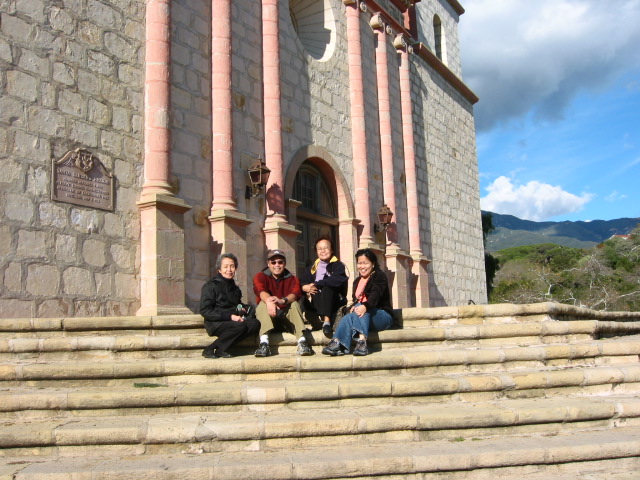
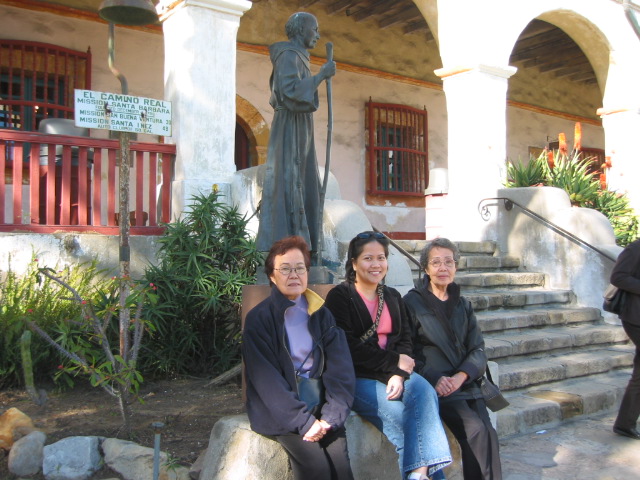
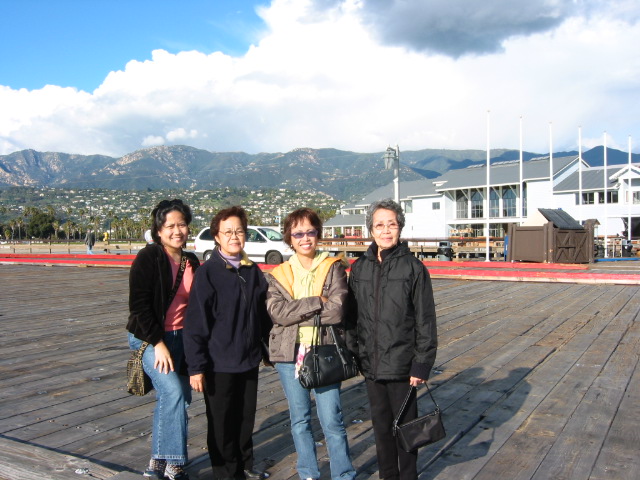
The tight but busy streets of downtown Santa Barbara guided us in our search for Highway 154 as we preferred to venture the twisting but spectacular San Marcos Pass rather than to return to Buellton using the now, for us, redundant Highway 101.
The Santa Ynez mountains run like a wall along the south coast of California that stretch from east to west. There are only three routes out of Santa Barbara to the north that cross these mountains: Gaviota Pass, Refugio Pass, and San Marcos Pass. San Marcos Pass is the shortest route of these three. The San Marcos Pass summit is about 8 miles northwest of Santa Barbara.
San Marcos Pass, punctuated by spectacular views of Lake Cachuma and highlighted in part by the grandeur of the Los Padres National Forest and the San Rafael Mountains, is probably one of the most scenic roadways in the entire state of California.
The first people to live on San Marcos Pass were the Chumash. They originally called it “Malames”. The Chumash are now gone, but their memories linger on (courtesy of a classy resort/casino) and their rock paintings can still be found in many places on the Pass, among them, the Chumash Painted Cave State Historic Park.
We bade farewell to the San Marcos Pass as soon as we descended 154 and cut through the towns of Santa Ynez and Solvang to finally reach our hotel in Buellton via Highway 246…instead of continuing on to the historic town of Los Olivos – known for its numerous wineries as well as its expansive views of the Santa Barbara Valley. Both Highways 154 and 246 will eventually merge with Highway 101 somewhere along with their respective ways.
We could not resist the charm of ‘Europeanesque’, Solvang so we decided to refresh our flagging spirits by settling down into one of the cozier tables that also offered a nice view of the streets from inside the Mortensen’s Danish Bakery/Shop, where we had their ‘house special’ bread and coffee.
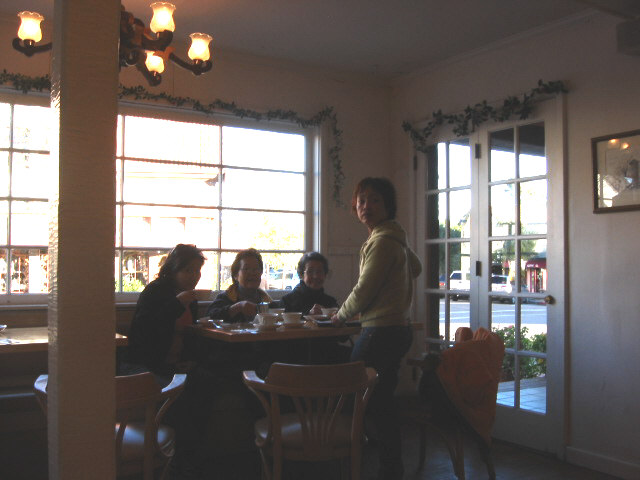
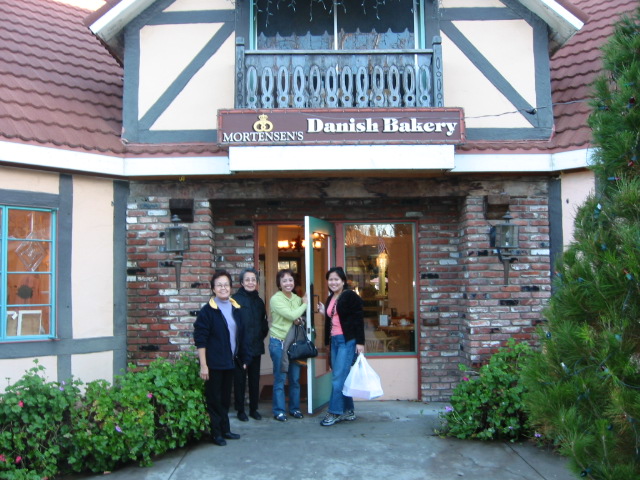
The bread’s unusually sweet fillings and the caffeine boost in the numerous cups of coffee we had, gave us back the energy we needed to continue on for the long night ahead. Pictures were taken along the brick-laden streets of Solvang as well as nostalgic sceneries among the horse ranches and the ostrich farm we passed-by, by on the way back to our hotel in Buellton.
It was already dark and the traffic discernably light -except for the brief but gaiety Christmas lights we saw at Solvang as our Jeep plodded back along Highway 246…perhaps wondering where all the magnificent vistas had gone – as we headed for the Chumash Casino and Resort – a convenient 15-minute drive from our hotel.
Once inside the casino, the creations of men and their mighty, money-making (or, shall I say, ‘money-taking’) slot machines plus the ritzy ambiance of the place, once again, tried to mesmerize us with the false sense of beauty of the materialistic-side of things on this part of the Earth.
We already knew better. The natural beauty of the places which we had all seen earlier, was already forever etched in our minds for as long as we will all live…and will be impossible, for any artificial places of recreation that will probably be created by man, to take them all away from us.
The Grapes of Highway 29
The Vigan ‘longanizas‘ (sausages from Vigan, which is a town about 250 miles north of Manila and noted for its rich Spanish heritage) smelled even more garlicky that morning as I placed the remaining links on a clear bowl.
The sausages casings’ red-brown color together with the fat that dripped from the fillings, blended oh-so deliciously, with the generous oil that had accumulated under them. Eaten at breakfast and served over hot, white rice with a good cup of coffee, these ‘longanizas‘ will definitely see you through a long day of travel…which we had planned that Thursday of Dec 16.
By 9:30 in the morning we had already traversed the busy cities that had dotted Highway 880 -and a bit of I-80 – and had coasted cleanly into the towns of Vallejo as soon as we had exited the first off-ramp after we paid the $3 toll in the recently-remodeled Carquinez Bridge. It is one of the major spans that link the upper portion of Northern California with the Bay Area.
Highway 29 cradled us the rest of the way as we headed towards the majestic plains of Alexander Valley, in a place called Geyserville. The destination may not rub well with the altruists, but the journey was, nevertheless, close to being ethereal.
As soon as we left behind the old city of Vallejo, the scenery immediately turned rustic and was perfectly complemented by endless vineyards that caressed the entire length of Highway 29. We passed by quaint towns along the winding roads of Napa and Calistoga.
Both these places offered a study in contrast to over-consumptive materialism and utterly simple living. In addition to their huge manses, there were the usual gas-guzzling SUVs and expensive sports cars casually parked inside the huge lots of the vineyard owners. On the other side of the coin, there were the humble, one or two-room abodes of farmers or retired folks who love to till their own lands.
Passing through these rustic towns also gave me a sense of wonder as to why, we, mere mortals had to endure the banalities of modern living –even when these seemingly plain (but spectacular) sceneries could fill our inherent craving for inner peace and joy, much stronger.
The plains of Alexander Valley unfolded right before our already mesmerized eyes after Highway 29 turned into Highway 128 and almost immediately after we passed-by the last town in Calistoga. Highway 128 meandered along the rollings hills of the Valley until you hit the small town of Geyserville. A short, stone and steel bridge -one of the many that spans the 50-mile long Russian River – should serve as a good marker that you’re on the right track to Geyserville.
Our destination wasn’t the town but the Indian casino now called River Rock. It used to be called ‘Dry Creek Rancheria’ but casino operators -with their esurient skills for making money – probably realized their folly in naming a money-maker that had already dried-out and renamed it to something that constantly flows instead.
The place was situated up a steep hill that was accessible via a narrow road along Highway 128. There were multi-storeyed parking garages and most probably, a hotel, undergoing construction. But, the squat, main casino building was already in full action –ready to take your money away.
The panoramic view of the valley from the 4th-level garage parking offered a bit of spiritual relief from the voracious appetite of the slot machines and gaming tables below.
It’s probably the very first Indian casino that I had been to where I felt that I didn’t even have the chance to win, just a few minutes after inserting my money on the slot machine. The slot machines over there were really tight. Even Larry Ellison would probably shudder at the thought of how those slot machines were programmed to give the house an unbeatable edge.
River Rock, the place, is definitely on my “to visit” list. Eat and enjoy the scenery. But avoid the casino as much as possible, please. You might want to play at neighboring Hopland instead (a 30-minute drive further north from Geyserville).
There, the less-sophisticated slot machines of the ‘Shokawah Hopland’ will welcome you their kinder and gentler arms.
All told, the fantastic sceneries and the grapes planted all throughout Highway 29 that led us to River Rock, only served as mute witnesses, to our follies, perhaps, in our ways for the never-ending quest for something meaningful in life.

